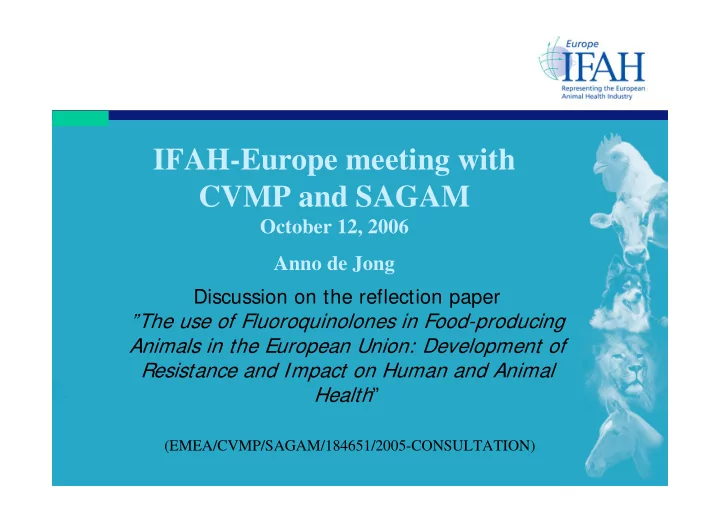

IFAH-Europe meeting with CVMP and SAGAM October 12, 2006 Anno de Jong Discussion on the reflection paper ”The use of Fluoroquinolones in Food-producing Animals in the European Union: Development of Resistance and Impact on Human and Animal Health ” (EMEA/CVMP/SAGAM/184651/2005-CONSULTATION) 1
Purpose • To comment and discuss scientific sections of the Report (SAGAM) • To propose and discuss prudent use wording and harmonisation actions (CVMP) • Ultimate aim is to improve the rational and responsible use of fluoroquinolones (FQs) in the EU 2
General • Appreciation for the well-balanced and constructive Report about the (fluoro)quinolone resistance status in Europe • IFAH-Europe is grateful to get the opportunity to review the document and for the organisation of this meeting • Agree to and strongly endorse the majority of statements and conclusions • Some questions, however, need to be addressed, and a revised final paper published 3
General Com m ents ( 1 ) • Considerable progress has been achieved regarding the prudent and responsible use of antimicrobial, including FQs, – e.g. introduction of Guideline CVMP/ VICH/ 644/ 01-Final. – Animal Health Industry also contributed to prudent use strategies by establishing prudent use guidelines for FQs and conducting resistance monitoring and antibiotic consumption surveys. • IFAH-Europe assumes that the Report refers to both quinolones and fluoroquinolones for food-producing animals 4
General Com m ents ( 2 ) • One approach is to contain resistant pathogens. Another approach should be to reduce the occurrence of food- borne pathogens as such, – this will lower the transmission of FQ-resistant pathogens. – Hence, Good Agricultural Practice (GAP) must have the highest priority • It might be beneficial to include which Qs/ FQs are approved, when, where and for which indication/ host species (e.g., on page 5 of the Report) 5
I FAH-Europe‘s m ajor concerns • Resistance mechanisms of FQs and breakpoint terminology (page 6 of Consultation Report) • Potential public health effects of Salmonella infections with reduced susceptibility to FQs • Fluoroquinolone-resistant Campylobacter infections • Animal health consequences 6
Mechanism s of resistance to FQs and breakpoint term inology • Resistance mechanisms should be slightly extended, � e.g. the activity of efflux pumps or changes in FQ entry could be addressed • IFAH-Europe appreciates that new breakpoint terminology has been adopted. � It is particularly important to differentiate between epidemiological cut-off values and clinical breakpoint values (4th para.; p. 6). • In this context, we request (in the same paragraph): – „resistance“ is replaced by „decreased susceptibility“ – „Enterobactericeae“is replaced by „Salmonella“, as was correctly done in the conclusions 7
Decreased FQ susceptibility and Salm onella infections ( 1 ) • I nterpretation of literature needs caution - Only few controlled studies; usually case reports, mainly S. typhi - Seriously-ill patients with underlying diseases - Treatment information limited (e.g. pre-treatment isolates, treatment not according to label, travel information) • Helm s studies - Absence of medical treatment information - Long post-treatment study periods - Cause of death not available; n limited - Multiple-resistance not addressed 8
Decreased FQ susceptibility and Salm onella infections ( 2 ) Duration of illness and lethality of patients of a German hospital with Salmonella infections caused by quinolone resistant and susceptible isolates (MICs in µg/ ml) Duration (median days) Patients n Median Age MIC 90 MIC 90 Mortality Disease Medication (% ) nalidixic Cipro- acid floxacin quinolone- 40 53 > 128 0.25 0 11 7 resistant (25 – 83) (5-15) quinolone- 40 48 4 0.015 0 10 7 susceptible (19 – 78) (3-13) Unpublished data, Schmitz & Werling, 2006 Conclusion: in this study quinolone resistance of Salmonella does not affect clinical outcome 9
Cam pylobacter I nfections ( 1 ) • Self-limiting disease; macrolides are the first choice drugs • Nelson et al (2004) study contains various flaws such as limited data for FQ shortens diarrhoea by 4 days for resistant infections, but not in patients infected with susceptible strains Cip R Cip S infections infections Mean days of 2 3 hospitalization Mean days of 3 4 missed work Nelson et al., 2004 10
Cam pylobacter I nfections ( 2 ) Campylobacter Sentinel Surveillance Scheme, UK; 2000 – 2003. Data set refers to 10843 cases: 8746 domestic cases and 2097 patients with foreign travel history Parameter Domestic/ Ciprofloxacin- Ciprofloxacin- resistant cases susceptible cases Travel Duration of d 11.1 11.4 disease (days) t 13.1 13.3 Hospital d 8.9 8.6 admission (% ) t 3.5 4.6 Hospitalization d 4.6 5.1 (days) t 4.3 5.2 data submitted for publication 11
Cam pylobacter I nfections ( 3 ) • Conclusions from Nelson study This study failed to convincingly demonstrate an impact on public health related to FQ resistance. FQ-resistant Campylobacter infections are not more severe than susceptible infections. • Conclusions from the Sentinel study FQ resistance does not affect the duration of illness. It also rejects the hypothesis that FQ-resistant Campylobacter display an increase in virulence. 12
Anim al Health Consequences • Target bacteria. Caution is needed to interpret Table 4; some figures may present an over-estimation of the resistance rates • IFAH-Europe fully endorses investigation of novel PK/ PD concepts. – But, without data-protection there is little incentive . � It is essential that significant investments in new data benefit from intellectual property protection • For some diseases, no or few alternative antimicrobials are available. It is important to retain the efficacy of FQs 13
Conclusions • Very valuable and constructive Report. Provides a well- balanced and comprehensive overview • IFAH-Europe would appreciate it if CVMP/ SAGAM could revise and republish the Consultation Report • Particularly, we feel the need to adopt current breakpoint terminology (7th paragraph of conclusions) and the conclusions regarding salmonellosis and campylobacteriosis (4th paragraph) 14
Recommend
More recommend